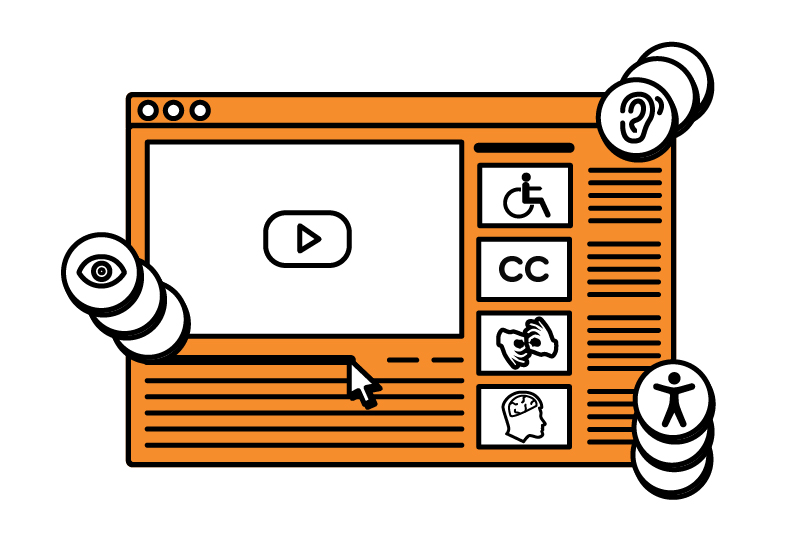
This is a guide to creating accessible content for people with disabilities. As content creators and consumers, we should be more aware of how we and other people navigate the internet.
What is accessible content?
Accessible content or accessibility is about improving comprehension for those who access content alternatively. People who have disabilities may also have issues with their ability to access content online. Some people with disabilities may use assistive tools such as captions, text-to-speech, voice control, hands free mouse tracking and more. These tools help disabled people navigate through the internet, similar to their assistive equipment in the real world.
Who is accessible content for?
For people:
- Who have visual impairments
- Who have colour-blindness
- Who are deaf or hard of hearing
- Who have impaired motor or mobility function
- Who have intellectual disability
- Who have cognitive impairment
Why is it important to make content accessible?
As abled people, we must strive to make it a standard to make all our content (digital and physical) accessible so our messages are sent out to a wider audience.
Tips for designing accessible content
Colour
- Use high colour contrast. To test your colour contrast, use resources like Colourable to meet Web Content Accessibility Guidelines (WCAG) 2.1
- Avoid green and red colours
- Ensure that there are no patterns in the background
Text and type
- Ensure fonts are appropriate and legible to read
- Ensure the type contrasts against the background
- Use shorter line lengths if possible, and increased letter spacing for easier reading experience
- Avoid communicating messages primarily using colour or logos alone
- If you do, provide an image description to clarify a message
Language
- Focus on the person, not their impairment by referring to the person first and their disability second (i.e.: “People with disability”, “Person who is deaf” or “People who have low vision”.
- Do not use “non-disabled” or “able-bodied” as it is non-inclusive. Use “person without disability” as it emphasises that people are not defined by their disabilities.
- Avoid language that implies people with disabilities are ‘bound’ by their assistive equipment. Use language like “wheelchair user” or “person who uses a wheelchair” instead.
- Don’t use language that victimises people with disability and remove the emotion from the language (i.e. “Sam suffers from cerebral palsy” to “Sam has cerebral palsy”)
- Write without jargon and in a way that your audience can understand.
Tips for designing digital accessible content
Audio
- Avoid low background noise
- Ensure that the audio levels are at an appropriate level
- Ensure that any speech is coherent and audible
- Ensure that all relevant unscripted content is recorded and transcribed
Video
- Avoid or minimise fast flashing or flickering content on the screen
- Ensure all relevant unscripted content is recorded and described in captions and transcripts
- Use audio descriptions
- Choose a current video format for the web
- Choose an accessible video player that supports captions, transcripts and audio descriptions
- Ensure that the video player controls can be operated with a keyboard
- Ensure that videos don’t automatically play when video loads
Captions, Transcripts and Audio Descriptions
- Captions help make media accessible to people who are hard of hearing or have hearing loss.
- Transcripts are text versions of your audio or video. It should include what is spoken and descriptions of actions or important information on the screen.
- A fully accessible video provides both captions and transcripts.
- If possible, add a sign language track for people who are hard of hearing or have hearing loss.
- Provide transcripts and captions as HTML and PDF forms for (looks like something is missing).
Image Descriptions
- Screen readers can’t interpret images and must rely on the text to read out loud the information on the page
- Some people with cognitive disability interpret text better than images
- Ensure all images on your website have an ALT text description. These descriptions can be read by text-to-speech readers for people who have poor eyesight or are blind.
Web design
Correctly coding your website is important for those who use screen reader tools to navigate the internet.
- Ensure your site can be operated with the keyboard
- Use Headings and tags correctly (H1, H2, H etc) to establish hierarchy
- Label forms correctly for accessibility. Ensure that each form is clearly labelled, as it may not be obvious for someone using a screen reader.
- Avoid using tables for anything except data.
- Enable resizable text for people with visual impairments
Thank you for reading our guide on how to create accessible content. At Leading Hand, we strive to be best practice in our content creation and representation for people with disabilities. We hope this guide was helpful for you.
